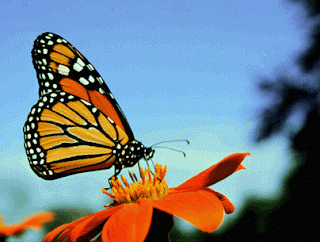
The Monarch is a common poisonous butterfly that eats poisonous milkweed in its larval stage and lays its eggs on the milkweed plant. Monarchs have a wingspan of 3 3/8 - 4 7/8 inches (8.6 - 12.4 cm). A color variation has been observed in Australia, New Zealand, Indonesia and the United States as early as the late 19th century. Named nivosus by Lepidopterists, it is grayish white in all areas of the wings that are normally orange. Generally it is only about 1% or less of all monarchs, but has maintained populations as high as 10% on Oahu in Hawaii, possibly due to selective predation.
Like all insects the Monarch has six legs, however it uses only four of its legs as it carries its two front legs against its body. The eggs are creamy white and later turn pale yellow. They are elongate and subconical, with approximately 23 longitudinal ridges and many fine traverse lines.A single egg weighs about 0.46 milligrams (0.0071 gr), and measures about 1.2 millimetres (47 mils) high and 0.9 millimetres (35 mils) wide.

 6:43 AM
6:43 AM
 sadmovement
sadmovement



 Posted in:
Posted in: 







0 comments:
Post a Comment